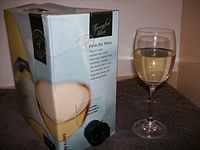- Box wine
-
A box wine (or boxed wine, goon, cask wine[1]) is a wine packaged as a Bag-In-Box. Such packages contain a plastic bladder protected by a box, usually made of corrugated fiberboard.
Contents
History
The process for packaging 'cask wine' (box wine) was invented by Thomas Angove of Angove's, a winemaker from Renmark, South Australia, and patented by the company on April 20, 1965.[2] Polyethelene bladders of 1 gallon (3.79 litres) were placed in corrugated boxes for retail sale. The original design required that the consumer cut the corner off the bladder, pour out the serving of wine and then reseal it with a special peg.[3]
In 1967 Charles Henry Malpas and Penfolds Wines patented a plastic, air-tight tap welded to a metallised bladder, making storage more convenient. All modern wine casks now utilise some sort of plastic tap, which is exposed by tearing away a perforated panel on the box.
Bag in a box packaging is also preferred by producers of less expensive wines because it is cheaper than glass bottles. A bag of wine, removed from the box, will float on water, allowing quick cooling of a white wine by immersion in an ice bath.[citation needed]
The packaging first found commercial success in the land of its invention Australia,[4] and while it has since established a steady market across Europe[citation needed] and South Africa, in the US the boxed wine has found difficulty in overcoming a down-market image.[5][6]
Pros and cons
Bag-in-box packaging has some advantages over bottles and is preferred by some wineries because it is far less expensive, lighter and more environmentally friendly than bottled wine[citation needed] and far easier to handle and transport. Boxed wine is typically cheaper than bottled varieties, often around A$10 (GBP£6, US$10) for 4 litres in Australia.[7]
The primary benefit that bag-in-box packaging offers to consumers is that it prevents oxidation of the wine during dispensing. After opening, wine in a bottle is oxidised by air in the bottle which has displaced the wine poured. Wine in a bag is not touched by air and thus not subject to oxidation until it is dispensed. Cask wine is not subject to cork taint or spoilage due to slow consumption after opening and can stay fresh for weeks after opening.[citation needed]
The bag is not hermetically sealed and has an unopened shelf life shorter than bottled wine.[citation needed] Most casks will have a best-before date stamped. As a result, it is not intended for cellaring and should be drunk within the printed period. Deterioration may be quite noticeable by 12 months after filling.[4]
Manufacturers of 'higher class' bottled wines[who?] have complained about the cheapness of 'cask' wines, arguing that they provide a cheap means for alcoholics to become inebriated. In particular, the lower level of alcohol excise levied on cask wine in Australia (compared to beer and bottled wine) has been criticised as encouraging binge drinking. Cask wine in Australia is colloquially referred to as "goon" which is a term derived from the word flagon meaning a large vessel used for drink, or "boxy", in reference to its low price and high alcohol content. Goon is actually an aboriginal word meaning "to drink" or "place of drinking", for example the Sydney suburb of Yagoona was a long form aboriginal name for "waterhole".[citation needed] Goon is the shortened version. [8]
Box wine has environmental benefits.[5] The bag allows a content of 2–10 litres, so that far less packaging mass is required.
See also
References
- ^ "Wine cask". Powerhouse Museum. http://www.powerhousemuseum.com/australia_innovates/?behaviour=view_article&Section_id=1000&article_id=10021. Retrieved 2007-03-05.
- ^ http://news.ninemsn.com.au/national/8201840/eclectic-mix-honoured-on-australia-day
- ^ "Wine cask". Powerhouse Museum. http://www.powerhousemuseum.com/australia_innovates/?behaviour=view_article&Section_id=1000&article_id=10021. Retrieved 2008-01-27.
- ^ a b winepros.com.au. The Oxford Companion to Wine. "boxes, wine". http://www.winepros.com.au/jsp/cda/reference/oxford_entry.jsp?entry_id=430.
- ^ a b Colman, Tyler, The New York Times (August 17, 2008). Drink Outside the Box
- ^ Colman, Tyler, Forbes.com (July 16, 2009). Box Wines That Can Be A Hit
- ^ "Cask Wine". Time Out Sydney. 2009-01-01. http://www.timeoutsydney.com.au/barspubs/drinksrecipes/cask-wine.aspx. Retrieved 2009-12-13.
- ^ "Drinking problem is lack of will on overall measures". Sydney Morning Herald. 2007-06-30. http://www.smh.com.au/news/opinion/drinking-problem-is-lack-of-will-on-overall-measures/2007/06/29/1182624168792.html?page=2. Retrieved 2007-08-04.
Categories:- Australian inventions
- Food storage containers
- Wine terms
- Wine packaging and storage
Wikimedia Foundation. 2010.

